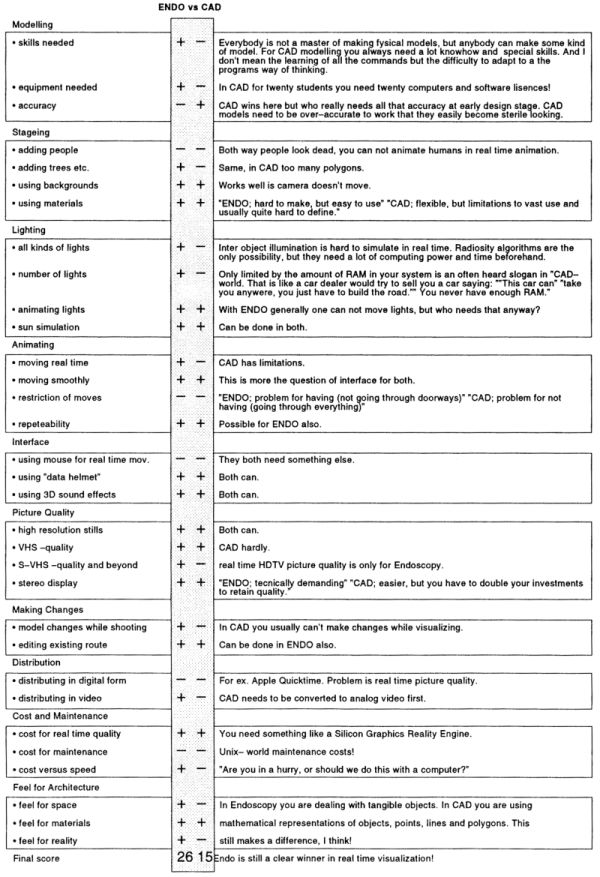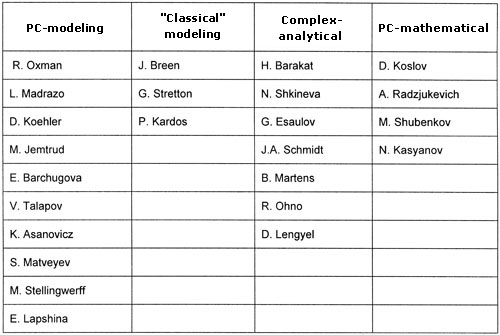special EAEA
 |
|
 |
ARCHITECTURE AND MODERN INFORMATION TECHNOLOGIES
МЕЖДУНАРОДНЫЙ ЭЛЕКТРОННЫЙ НАУЧНО-ОБРАЗОВАТЕЛЬНЫЙ ЖУРНАЛ ПО НАУЧНО-ТЕХНИЧЕСКИМ И УЧЕБНО-МЕТОДИЧЕСКИМ АСПЕКТАМ СОВРЕМЕННОГО АРХИТЕКТУРНОГО ОБРАЗОВАНИЯ И ПРОЕКТИРОВАНИЯ С ИСПОЛЬЗОВАНИЕМ ВИДЕО И КОМПЬЮТЕРНЫХ ТЕХНОЛОГИЙ
THE BASIC IDEA OF THE 8-TH CONFERENCE EAEA AND ITS PRACTICAL REALIZATION
Mikhael Matalasov
MARKHI (State Academy), Moscow, Russia
"Due to computers the designing becomes "other". Whether is "the difference" the sufficient factor for the recognition "of computer designing" by best? The author of the present dissertation holds the opinion, that it is not. "Other" does not designate the best, as does not designate the worst. "Other" designates - other, irrespective of, whether we design by a traditional way or in "cybernetic-real space"".
From doct. dissertations of Alexander Asanowicz
Introduction
As one of the authors of the proposed conference theme - “Virtual environment and experience: Shared-IN-sight” I would like to explain my point of view. My approach is grounded on a long-time experience in this field, on results of the constant interchange of experience with colleagues from the ЕАЕА and consists in the following: a material “analogue” person exists in a material “analogue”" world. During his existence he may need simulating of the surrounding world with the purpose of its analysis, transformation …
And here there appears the following chain of possibilities:
REAL (MATERIAL) WORLD - PHYSICAL FULL-SCALE (ANALOGUE) SIMULATION (MINIMUM ABSTRACTING) – PHYSICAL SMALL-SCALE (ANALOGUE) SIMULATION (MODELLING), INCLUDING THE CONSEQUENT ARRANGING OF THE MODEL IN THE EXISTING (VIDEOSHOOTING,) VIDEOWORLD (MAGNIFICATION OF ABSTRACTING) - DIGITAL SIMULATION, INCLUDING CONSEQUENT ARRANGING OF THE DIGITAL MODEL IN THE EXISTING (VIDEOSHOOTING) ANALOGUE “VIDEOWORLD”, (FURTHER MAGNIFICATION OF ABSTRACTING) – “VIRTUAL REALITY” AS THE HIGHEST LEVEL OF ABSTRACTING (A MATERIAL “ANALOGUE” MAN IN A “VIRTUAL” DIGITAL WORLD).
At the same time it is possible to note, that it becomes “fashionable” to create “virtual” design spaces and put into them a person furnished with multimedia facilities for “being present in them”. Except for the visual and acoustical “perception” it is possible for example to model odours, gustatory sensations, and taction. It seems to speak about reality of person’s presence in “virtuality”, though actually there is some “impoverishment” of the man, i.e. as if partial transformation of him also into a “digital” model. After that it is declared, that his perceptions in the “virtual” world will be adequate to perceptions in a real world created according to the “virtual”model. It is an “ocean” of studies for psychologists, philosophers …
Why was it in the European association of architectural endoscopy (ЕАЕА) that the conference theme mentioned above has arisen and been supported?
The advantage of the ЕАЕА consists in the fact that within the framework of our conferences (and outside of them) problems concerning first of all the methods of perception and study of objects, instead of instruments, even so “perfect” as computer, are considered. While there is a material world, there should exist also material methods of its simulation.
An important feature is also an equal consideration of physical models alongside with digital ones, it was begun in 1993 on the first conference of the ЕАЕА in Tampere (Petri Siitonen, Helsinki University of Technology) (Table 1).
Table 1. Comparison of endoscopy and computers in modeling (1993)
In Table 1 an attempt was made for the first time to select criteria (today - many of them are naive) for the comparison of two directions in simulation and possibility of considering results. That period was characterized by a rather broad employment of endoscopic installations of different degrees of complexity for analysing physical models from real view points. Optical systems and electronic devices connected with them were perfected, and miniaturization of video cameras began.
Reality, the tangibility of physical models ensured and ensures the conclusiveness of received results.
At the same time personal computers began to spread, special software began to be developed. Their abilities were originally rather restricted and at that moment there were few people who expected their consequent rapid progressing. But basic discrepancy between interaction of the man and engineering devices was already established. If endoscopic devices were in principle “passive” participants of the designing process and played a supplementary role, the essence itself of personal computers supposed and supposes a role of a “partner” of the design process, of an “active” instrument.
This results inevitably in a more “static” development of endoscopic methods against the background of rapid “revolutionary” development of computer technologies. It can be seen, analyzing table 1 - that, which concerns endoscopic methods, has not changed basically (without losing its main advantage - tangibility - physical presence, that is especially valuable and important at early stages of educational process.)
The method of contraposition shown in the table is not quite true if we take into account everything mentioned above. Unfortunately, attempts of contraposition exist even now, though there have appeared opinions on looking for rational interaction of different methods and devices, proceeding from the most effective achievements of the design purpose. It is seen also in a series of the reports of the 2007 conference.
With the development of technologies of “virtual” (digital) representations a problem of truthfulness of representations becomes even more urgent. Constant controversies are carried on discussing, whether the “virtual reality” will replace traditional means of presentation, what advantages has traditional architectural endoscopy in comparison with digital technologies (and on the contrary).
Spectrum of interests
The analysis of the reports submitted to the conference makes it possible to form factitiously the following groups (Table 2).
Table 2.DISTRIBUTION OF REPORTS AMONG FACTITIOUS GROUPS
The main thing that it would be desirable to note - practically all presented works concern directly the training process.
The greatest number of participants - 10 - are grouped in column 1 (called “Computer" simulation), representing a wide range of various and interesting works, which corresponds to broad employment of modern computer technologies in educational process. Not discussing the concrete authors, with whose works the reader can get acquainted himself, we shall mention only the main directions of research. 2 reports are dedicated to students' works at the creation of abstract spaces, and in one of them the IN-SPACE programme worked out by the authors is used. In three reports the creation of the computer models of historical objects are analyzed, two reports acquaint us with research works connected with various aspects of creation and usage of “virtual spaces” and in one the perception of space with regard for influence of artificial lighting. It would be desirable to note especially two non-standard reports. In one of them creation and work of the joint design studio on the basis of two remote students' groups (Montreal - Pennsylvania) are depicted, the virtues and deficiencies of such remote interaction are shown, organization and software of the created immersion informative and communication space are depicted. The second report describes the possibilities of the Google system in educational architectural designing.
Though column 2 (“Classic” simulation) contains only 3 reports, the authors demonstrate definite advantages of traditional methods in educational process.
Column 3 (Complexly - analytical) comprises somewhat fewer works in comparison with column 1, but one part of them corresponds (as much as possible) to conception of the conference, because in them in this or that way the analysis and confrontation of problems of physical (analogue) and computer (digital) simulation are done.
And, at last, column 4 (PC - mathematical) contains works, dedicated to some extent to theoretical problems of computer simulation.
Conclusions
Summarizing, it is possible to say the following:
1. Taking into account the conference time-limit we think that it has created “starting” conditions for further research work announced in its theme.
2. Preparation of the 8th conference and experience of the seven preceding ЕАЕА conferences have made us think about the necessity of enlarging the number of like-minded persons and more intensive dialogues. As the realization of this thought the idea of creating in MARCHI a new electronic international scientific-educational journal “Architecture and Modern Information Technologies” (AMIT) has arisen and been realized, you are able to get acquainted in more details with its issues.
a
















